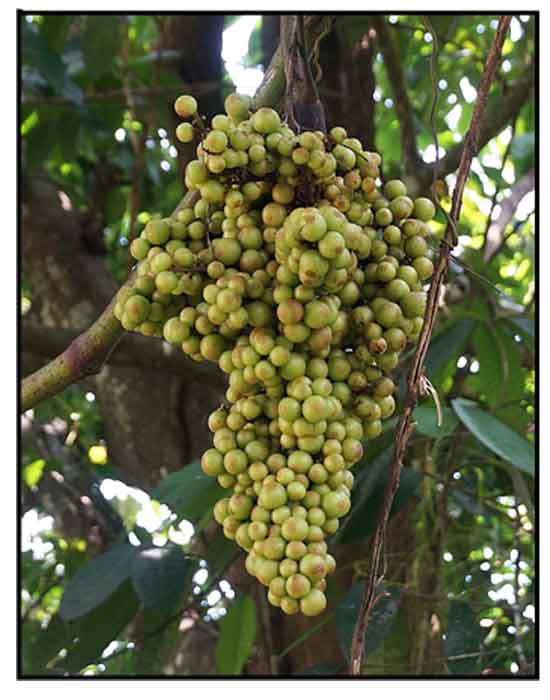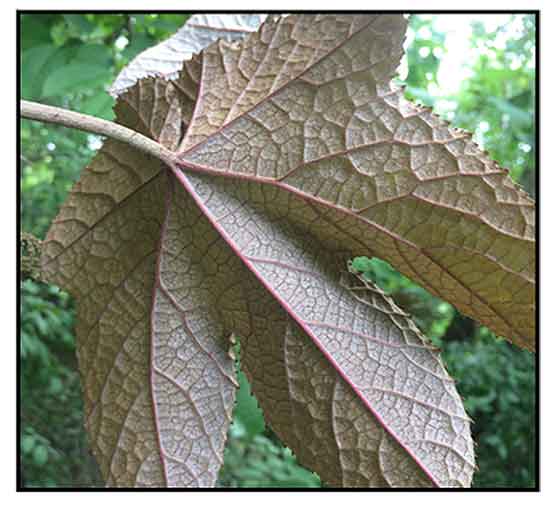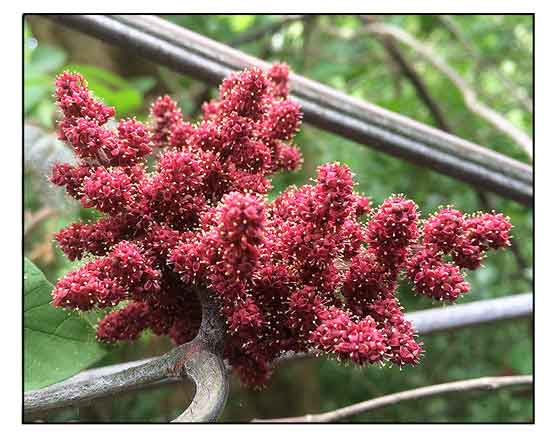 Gen info Gen info
- Ampelocissus is a genus of Vitaceae comprising 90 or more species.
- Ampelocissus martini is a climbr or shrub. A variant species spelling is martinii.
- The species was first named by French botanist Jules Emile Planchon (1823-1888), the name first published in 1884 in the journal Vigne Americaine et La Viticuture en Europe (Jour. Vigne Am.). (10)
Botany
• A large woody vine with tuberous roots and conspicuous tendrils. Leaves 3-lobed, velvety on lower surface. Fruit a globose berry, 1 cm in diameter, reddish-purple to black, in large bunches together. (2)
• A climber or shrub. Leaves are simple but sometimes lobed; arachnoid hairs on stems and petioles along with dark erect glandular hairs; pyramidal or elongated compact inflorescence, longer than wide, absent pedicels, or less than 1mm long; the flowers are either sessile or with less than 0.4mm long pedicels. It flowers in July and August in Cambodia, with fruiting occurring in September and October and leaves present from May to November. (10)
Distribution
- Native to the Philippines.
- Also native to Borneo, Cambodia, Laos, Malaya, Thailand, Vietnam. (1)
 Constituents Constituents
- Fresh juice extract showed high TPC and TFC, especially from black color, with 11.37 mg GAE/g FW and 19.41 µM FeSO4/g FW, respectively. (see study below) (3)
- Phytochemical screening of various extracts yielded terpenoid, flavonoid, saponin, phenolic acid and alkaloid. Methanolic extract of vines and rhizomes yielded higher total phenolic (1.96 mg and 4.22 mg GAE/g CE) and flavonoid contents (4.00 mg and 8.08 mg RU/g CE, respectively) than the ethyl acetate and hexane extracts. (see study below) (6)
- Study of roots led to the isolation of five resveratrol oligomers viz., (-)-ampelopsin F (1), (+)-hopeaphenol (2), (-)-α-viniferin (3), (-)-wilsonol A (4), and (-)-stenophyllol B (5). (see study below) (7)
- The ethyl acetate fraction and aqueous acetone fractions of roots showed highest total phenolic content and total proanthocyanidine content, respectively.
(see study below) (8)
Properties
- Fruit is similar to cultivated grapes.
- Studies have suggested antioxidant, antibacterial, enzyme inhibitory properties.
 Parts used Parts used
Leaves, roots, bark.
Uses
Edibility
- Fruits are edible, sweet and acid. Unripe fruits eaten with salt.
- Fruits used for making jelly.
Folkloric
- In Vietnam, root used as tonic.
- Roots used for treatment of sexual diseases.
- In Thailand, leaves used for treatment of asthma; vine as mild laxative and cough remedy; the roots for treatment of bruises and cough. In the Isan region, bark and roots used for treatment of swellings. (3)
Studies
• Antioxidant / Antibacterial / Fruit Juice: Study evaluated fresh juice extracts (FJE) of wild grape fruits in different colors of green, red, and black for phytochemicals and antioxidant activity. FJE showed high TPC and TFC, especially from black color, wit 11.37 mg GAE/g FW and 19.41 µM FeSO4/g FW, respectively. Green FJE exhibited highest antioxidant activities by DPPH and FRAP assays. Red FJE showed antibacterial activity against 14 strains, while the green FJE showed activity against 6 pathogenic strains. (3)
• Antioxidant / Fruit: Study evaluated the phytochemical, antioxidant, and antibacterial activities of methanolic extracts of wild grape fruits in different stages of maturity. Young fruits yielded highest phenolic and total flavonoid while ripe extract showed highest anthocyanin and total saponin. On DPPH assay, young wild grape showed low IC50 of 41.50 µg/mL, and highest scavenging of ABTS radicals at 18.96 µg/mL. Extract from young stage showed highest FRAP (15.76 mM FeSO4/g) and CUPRAC (17.13 mg TE/g), indicating high antioxidant activities. (4)
• Enzyme Inhibition / Antimicrobial / Seeds: Study evaluated the enzyme inhibition (anti-glucosidase and anti-tyrosinase) and antimicrobial (MIC, MBC, time killing assay) activities of fractionated extracts of wild grape seeds in different growth stages. Subfraction of immature stage eluted by ethyl acetate/methanol at 75/25 % v/v showed highest enzyme inhibition activity and most potent efficiency for time kill profiles. (5)
• Antioxidant / Phenolic and Flavonoid Content / Vine and Rhizome: Study evaluated the phytochemical and antioxidant activities of hexane, ethyl acetate and methanol crude extracts of vines and rhizomes of A. martini. Methanol extracts of vines and rhizomes showed higher total phenolic and flavonoid contents than ethyl acetate and hexane extracts. The ME and EA extracts of both parts showed higher antioxidant activities than hexane extracts. There was positive correlation coefficients were observed between total phenolic and flavonoid contents and between DPPH and ABTS. (see constituents above) (6)
• Anti-HIV-1 Activity / Resveratrol Oligomers / Roots: Study of roots led to the isolation of five resveratrol oligomers viz., (-)-ampelopsin F (1), (+)-hopeaphenol (2), (-)-α-viniferin (3), (-)-wilsonol A (4), and (-)-stenophyllol B (5). Compound 1 exhibited potential inhibition in anti-HIV 1-RT assay with IC50 in the range of 1.68-5.85 µM better than positive control, navirapin (IC50 7.77 µM). (7)
• Antidiabetic / Alpha-Amylase Inhibitory / Antioxidant / Roots: Study evaluated the phytochemical, antioxidant activity, and alpha-amylase inhibitory activity of aqueous acetone extract and fractions of roots. The ethyl acetate fraction and aqueous acetone fractions showed highest total phenolic content and total proanthocyanidine content, respectively. Aqueous actone fraction showed higher antioxidant activity. Acarbose and all samples except for aqueous methanol fraction inhibited alpha-amylase, a key enzyme linked to T2DM in a dose-dependent manner, with the aqueous acetone fraction showing strongest inhibition. Correlation analysis showed strong positive correlations between proanthocyanidin content, antioxidant activity, and alpha amylase inhibitory activity. Results suggest the aqueous acetone fraction, proanthocyanidins-rich fraction from root has potential for the management of diabetes via its high antoxidant activit and alpha-amylase inhibitory activty. (8)
• Hepatoprotective / Tert-butyl Hydroperoxide-Induced Toxicity via Nrf2-Mediated Heme Oxygenase: Study evaluated 64 crude ethanol extracts of Cambodian medicinal plants for hepatoprotective activities against t-BHP-induced cytotoxicity in human liver-derived HepG2 cells and assessed their cytoprotective mechanism pertaining to expression of heme oxygenase (HO)-1 and nuclear factor E2-related factor (Nrf2). Ampelocissus martini was one of 19 extracts that exhibited high protective activities. (9)
Availability
Wild-crafted.
|

![]()






